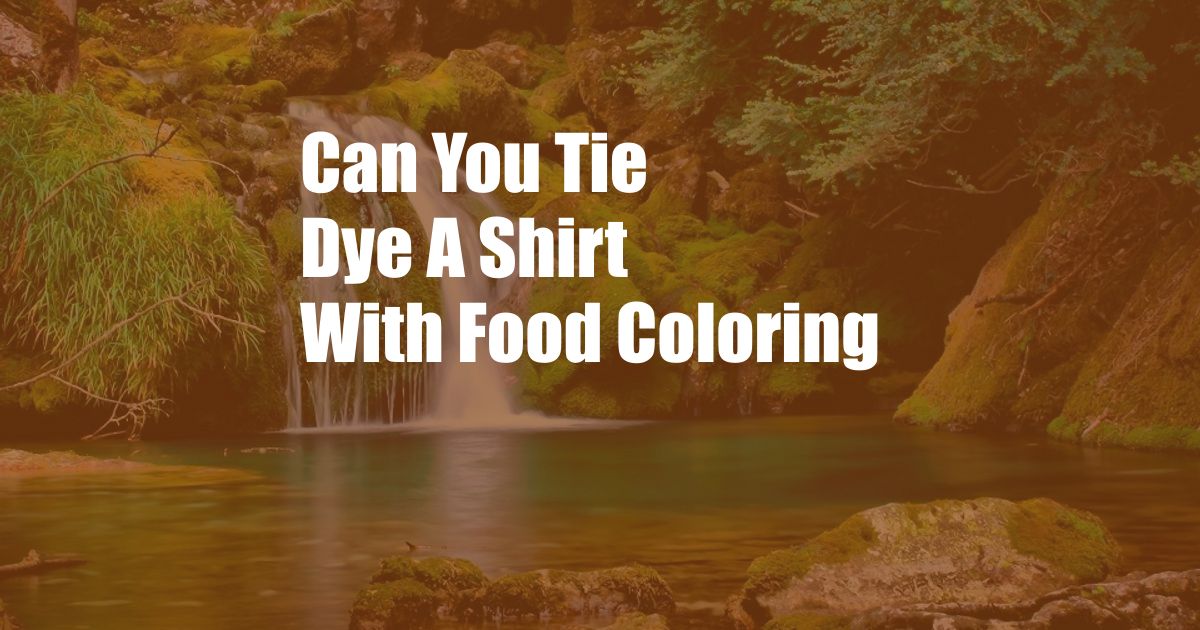
Can You Tie Dye a Shirt with Food Coloring?
As a kid, I loved tie-dye parties. The anticipation of seeing the vibrant colors and patterns emerge on my white T-shirt was always thrilling. Our kitchen turned into a colorful mess, but it was worth it for the vibrant creations we made. One day, I wondered, could I skip the chemical dyes and use food coloring instead? Curiosity got the better of me, and so I embarked on an experiment that would change my tie-dye game forever.
My experiment revealed that, yes, you can absolutely tie dye a shirt with food coloring. The results are not as vibrant as with chemical dyes, but they still create beautiful, one-of-a-kind patterns. In this article, I’ll share everything I’ve learned about tie-dyeing with food coloring, including tips, techniques, and the science behind the magic.
Different Fibers and Their Effect on Color
Before we dive into the process, let’s talk about different fabric types and their compatibility with food coloring. Natural fibers like cotton and linen absorb food coloring better than synthetic fibers such as polyester. This is because natural fibers have more hydroxyl groups, which are chemical groups that attract and bind to the dyes.
If you’re using a blend of natural and synthetic fibers, the natural fibers will take on the color more intensely. To enhance the color absorption, consider pre-washing your shirt in hot water. This will open up the fibers and make them more receptive to the dye.
Creating the Dye Solution
The next step is to prepare your food coloring solution. In a large bowl or container, mix a few tablespoons of food coloring with a cup of hot water. Stir until the food coloring is completely dissolved. The amount of food coloring you use will depend on the desired color intensity. For pastel shades, add less food coloring, and for vibrant hues, use more.
Food coloring comes in liquid, gel, and powder form. Liquid food coloring is the most common and easiest to use. Gel food coloring is more concentrated, so you’ll need to use less. Powdered food coloring is the most intense, so use it sparingly.
Tie-Dyeing Techniques
Once your dye solution is ready, it’s time to start tie-dyeing! There are countless tie-dye techniques out there, each creating unique patterns. Here are a few popular methods:
- Spiral Tie-Dye: Gather the shirt in the center and start twisting it like a spiral. Secure the spiral with rubber bands.
- Scrunch Tie-Dye: Scrunch up the shirt randomly and secure it with rubber bands. This creates a more abstract pattern.
- Reverse Tie-Dye: Soak the shirt in bleach solution, then tie it up and dye it. This technique creates a more subtle, bleached-out effect.
Experiment with different techniques to find the ones you like best. Remember, the key is to have fun and be creative.
Setting the Dye
After you’ve tied and dyed your shirt, it’s essential to set the dye to prevent it from fading. To do this, place the dyed shirt in a large pot or bucket filled with cold water. Add a cup of vinegar to the water and stir. Soak the shirt for 30 minutes, then rinse thoroughly in cold water.
Once the shirt is rinsed, lay it flat to dry. Do not wring or twist the shirt, as this can cause the dye to run. Once the shirt is completely dry, you can iron it to smooth out any wrinkles.
Troubleshooting Tips
If you encounter any problems during the tie-dye process, here are a few troubleshooting tips:
- The colors are too light: Use more food coloring in the dye solution.
- The colors are uneven: Make sure the shirt is completely saturated with the dye solution before tying it up.
- The dye is bleeding: Soak the shirt in a cold vinegar bath for longer. You can also try using a color-setting spray.
Frequently Asked Questions
- Q: Can I use any type of food coloring? A: Yes, you can use any type of food coloring, but liquid food coloring is the easiest to use.
- Q: Do I need to pre-wash my shirt? A: Yes, it’s a good idea to pre-wash your shirt in hot water to remove any starch or oils that could prevent the dye from absorbing.
- Q: How long does the dye stay on the shirt? A: With proper care, the dye will last for several washes.
- Q: Can I use food coloring to tie-dye other fabrics? A: Yes, you can use food coloring to tie-dye other natural fibers, such as linen, silk, and rayon.
Conclusion
Tie-dyeing with food coloring is a fun and easy way to create unique and colorful clothing and accessories. The process is simple, and the results are always one-of-a-kind. So, if you’re looking for a way to add some personality to your wardrobe, give tie-dyeing with food coloring a try. You might just be surprised at how much you love it.
Are you interested in learning more about tie-dyeing with food coloring? Let me know in the comments below, and I’ll be happy to answer any questions you have.